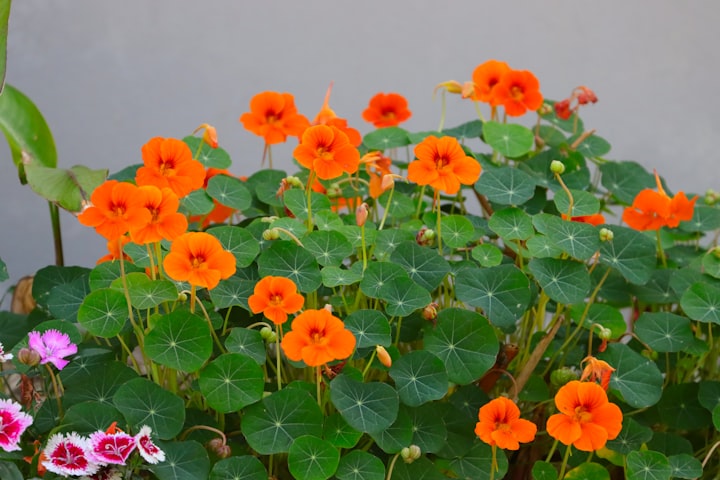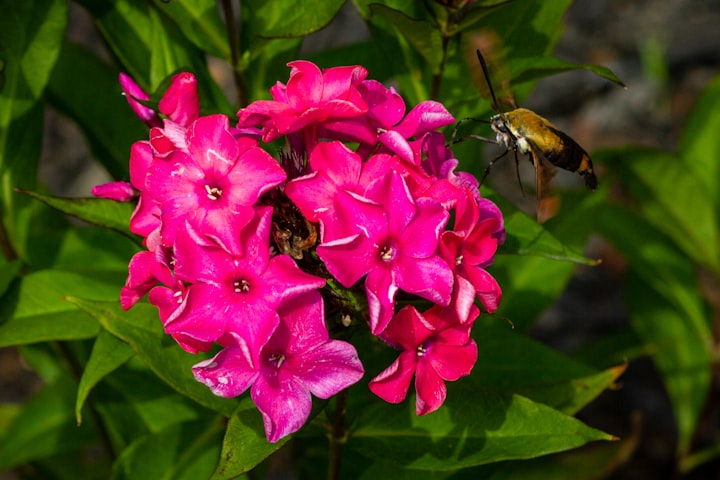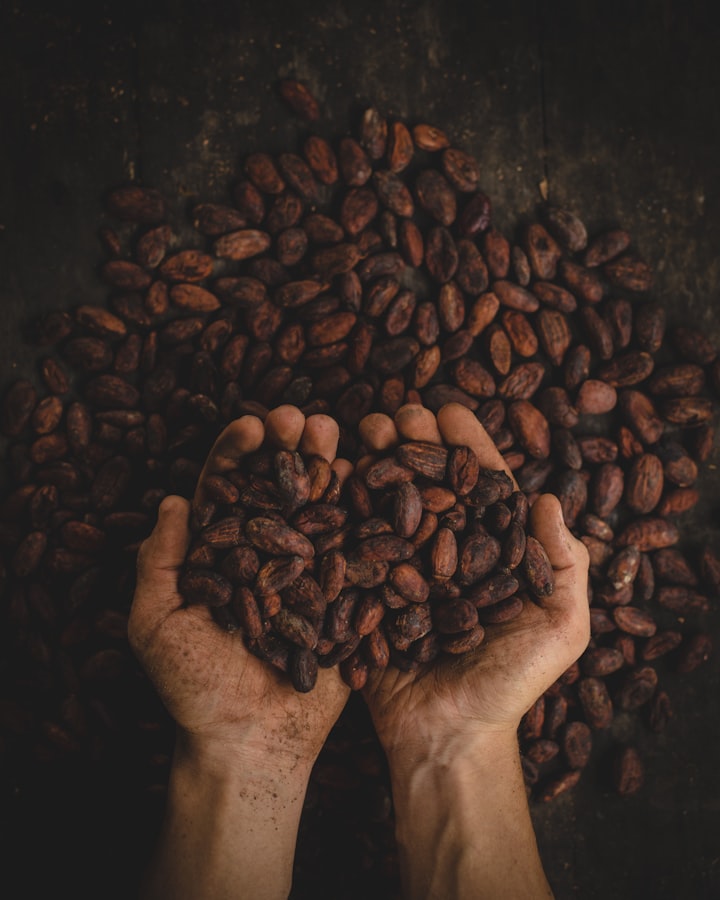Nasturtium 101: Guide to Growing and Caring
Tropaeolum

Nasturtium, known by its scientific name Tropaeolum, is a genus of flowering plants belonging to the family Tropaeolaceae. These plants are native to South America, particularly the Andes region.
They are popular garden plants known for their vibrant flowers and edible leaves and flowers. Nasturtium flowers come in various colors, including shades of orange, yellow, and red. The flowers are trumpet-shaped and have a distinctive spur at the back. The leaves are rounded and can be light green or bluish-green.
One of the notable features of nasturtiums is their peppery and slightly spicy taste, which is why they are sometimes referred to as "Indian cress." The leaves and flowers are edible and can be used in salads, sandwiches, or garnish. The flowers are often used to add color and flavor to dishes, while the leaves can be used as a substitute for watercress.
Nasturtiums are also appreciated for their ornamental value. They are commonly grown in gardens and containers, and their trailing or climbing growth habit makes them suitable for hanging baskets or trellises. They are relatively easy to grow and are often used as companion plants to deter pests, as their aromatic scent can repel certain insects.
Nasturtium Varieties
Nasturtiums (Tropaeolum) come in a delightful array of varieties, each offering unique charm and characteristics. Explore the diverse world of nasturtium cultivars to find the perfect fit for your garden:
- Tall/Cliff Nasturtiums (Tropaeolum majus): These are the classic nasturtiums with long trailing or climbing vines. They showcase abundant, vibrant orange, yellow, and red flowers. Popular cultivars include 'Empress of India,' known for its deep crimson flowers, and 'Moonlight,' which boasts creamy yellow blossoms.
- Bush/Dwarf Nasturtiums (Tropaeolum minus): Ideal for smaller spaces or container gardens, bush nasturtiums offer compact growth habits and neat mounds of foliage. They are available in various colors, including pastels and bi-colors. 'Tom Thumb' is a well-known dwarf variety with red, orange, and yellow flowers.
- Variegated Nasturtiums: These cultivars feature unique foliage, adding visual interest to the garden. Look for varieties like 'Alaska' with marbled green and white leaves or 'Whirlybird Variegated' with cream-edged foliage and vibrant flowers.
- Empress Nasturtium (Tropaeolum nanum 'Empress'): This fantastic variety stands out with its abundant double flowers in rich shades of velvety crimson. Its lush, rosette-like blooms create a regal and dramatic statement in the garden.
- Canary Creeper (Tropaeolum peregrinum): Unlike other nasturtiums, the canary creeper is a vining perennial variety. It showcases stunning, fringed yellow flowers that resemble tiny canaries in flight. This variety adds a touch of uniqueness and elegance to fences, trellises, or arbors.
- Whirlybird Nasturtium (Tropaeolum majus 'Whirlybird'): These nasturtiums feature semi-double flowers with unique whirlwind-like petals. They come in various bright and cheerful colors, including red, orange, yellow, and cream. Whirlybird varieties are known for their abundant blooms and vigorous growth.
- Jewel Nasturtium (Tropaeolum majus 'Jewel Mix'): As the name suggests, this mix offers a treasure trove of jewel-toned flowers. From rich, velvety reds to deep purples and glowing oranges, the jewel nasturtiums add a touch of royalty to any garden setting.
- Alaska Nasturtium (Tropaeolum majus 'Alaska'): This popular variety features lovely green leaves with creamy white marbling, creating a stunning contrast against its bright flowers. The Alaska nasturtiums are available in various colors, including red, orange, yellow, and peach.
When choosing nasturtium varieties, consider available space, desired growth habits, flower color preferences, and unique foliage characteristics. Mixing different cultivars can create a visually captivating display, adding color and interest to your garden beds, borders, or containers.
Ideal Growing Conditions
To ensure optimal growth and blooming, nasturtiums thrive under specific growing conditions. Here's what you need to know:
Sunlight: Nasturtiums love basking in the sun. They prefer full sun to partial shade, with at least 6 hours of direct sunlight daily. Placing them in a location with ample sunlight will promote sturdy growth and abundant flowering.
Temperature: Nasturtiums are warm-season plants and prefer moderate temperatures. The ideal temperature range for their growth is between 60°F (15°C) and 75°F (24°C). They can tolerate some cooler temperatures but are sensitive to frost. Plant them after the danger of frost has passed, and protect them from late spring or early autumn frosts.
Also Read: Guide to Growing Hellebore Flowers
Soil: Nasturtiums are adaptable to different soil types but thrive in well-drained, fertile soil. The soil should have good moisture retention capabilities without becoming waterlogged. Ideally, the soil pH should be slightly acidic to neutral, ranging from 6.0 to 7.0.
Air Circulation: Good air circulation around nasturtium plants is important to prevent the development of fungal diseases. Plant them with enough spacing to allow for proper airflow between the plants. This will help reduce the risk of powdery mildew or other moisture-related issues.
Growing Containers: Nasturtiums can also be grown in containers or hanging baskets. Choose containers with adequate drainage holes to prevent waterlogging. Use a well-draining potting mix and ensure the containers receive sufficient sunlight and regular watering.
Planting Nasturtiums
Nasturtiums are relatively easy to grow from seeds, and their colorful blooms can bring joy to any garden. Follow these steps to ensure successful planting:
Timing
Nasturtium seeds should be sown directly in the soil after the last frost date in your region. Wait until the soil has warmed up and temperatures consistently reach around 55°F (13°C) or higher.
Soil Preparation
Nasturtiums are adaptable to various soil types but prefer well-drained soil with good fertility. Before planting, prepare the soil by removing weeds, rocks, and debris. Loosen the soil to a depth of about 6-8 inches and amend it with organic matter such as compost or well-rotted manure to improve its structure and nutrient content.
Seed Sowing
Nasturtium seeds are large and easy to handle. Here's how to sow them:
i) Choose a sunny spot in your garden or prepare containers with adequate drainage holes if planting in pots.
ii) Sow the seeds about 1 inch deep into the soil, spacing them 8-12 inches apart, depending on the variety. Alternatively, you can sow them in groups or rows for a denser display.
iii) Cover the seeds with soil and gently firm it down, ensuring good seed-to-soil contact.
iv) Water the area gently to settle the soil and provide moisture for germination.
Germination and Seedling Care
Nasturtium seeds germinate within 7 to 14 days. During this time, keep the soil consistently moist but not soggy. Once the seedlings emerge, thin them if necessary, leaving the strongest and healthiest ones with proper spacing. Thinning ensures better airflow and reduces competition for nutrients and sunlight.
Transplanting Seedlings (Optional)
If you choose to start your nasturtiums indoors or in seed trays, you can transplant them into the garden once they have developed a few sets of true leaves and the risk of frost has passed. Harden off the seedlings gradually by exposing them to outdoor conditions for a few hours each day for a week before transplanting.
Nasturtium Care
Regular care and maintenance are essential to ensure the optimal health and beauty of your nasturtium plants. Follow these guidelines to provide the care they need:
Watering
Nasturtiums prefer moderate watering. Water the plants consistently, aiming to keep the soil evenly moist. You may need to water them more frequently during hot and dry periods. Be cautious not to overwater, as excessive moisture can lead to root rot or other fungal diseases. Water the base of the plants, avoiding wetting the leaves, which can encourage fungal issues.
Fertilization
Nasturtiums are relatively low-maintenance plants that don't require heavy fertilization. Over-fertilizing can lead to excessive foliage growth at the expense of blooms. However, you can sparingly apply a balanced, all-purpose fertilizer during the growing season to provide some nutrients. Alternatively, enrich the soil with organic matter, such as compost or well-rotted manure, before planting to improve fertility.
Read Also: Growing and Maintaining Hydrangea Plants
Mulching
Apply a layer of organic mulch, such as straw or shredded leaves, around the base of your nasturtium plants. Mulching helps retain moisture, suppress weeds, and regulate soil temperature. It also protects the shallow roots of the plants.
Pruning and Deadheading
Regularly remove faded flowers and any damaged or diseased foliage. This process, known as deadheading, promotes continuous blooming and prevents the plants from going to seed prematurely. Pruning back leggy growth can help maintain a compact and bushy form. Additionally, look for any signs of pests or diseases and take appropriate action promptly.
Pests and Diseases
Nasturtiums are generally resilient to pests and diseases but occasionally encounter challenges. Common problems that may affect nasturtiums include aphids, caterpillars, and whiteflies. Monitor your plants regularly and take appropriate measures, such as using insecticidal soap, neem oil, or organic pest control methods if necessary. Nasturtiums can also be susceptible to powdery mildew in humid conditions. Ensure proper airflow, avoid overhead watering and consider applying organic fungicides if needed.
Support for Climbing Varieties
If you're growing climbing nasturtium varieties, consider providing them with trellises, stakes, or fences to support their vining growth. Install the supports at planting or shortly afterward to avoid disturbing the roots later.
Harvesting and Pruning for Culinary Use
Harvest the flowers and leaves of nasturtiums when they are young and tender. They are edible and can add a peppery, slightly spicy flavor to salads, sandwiches, and other dishes. Regular harvesting encourages new growth and prolongs the blooming period. However, if you want to save seeds for the following year, allow some flowers to mature and dry on the plant.
Wrapping Up
In the enchanting world of gardening, nasturtiums stand out as vibrant gems that bring joy and flavor to any landscape. With their captivating blooms, peppery leaves, and easy-going nature, these plants have captured the hearts of gardeners and culinary enthusiasts alike.
From carefully planting the seeds in fertile soil to providing the ideal growing conditions, your efforts will be rewarded with lush foliage and a profusion of blooms. And as you harvest the edible treasures, the taste of your garden will unfold on your palate, an edible symphony that delights and surprises.
About the Creator
Amir Hossain
I blog on everything and anything— hoping my blogs will make your days a bit happier!






Comments
There are no comments for this story
Be the first to respond and start the conversation.